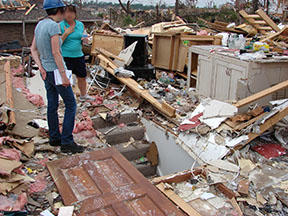Joplin Missouri Tornado 2011

National Construction Safety Team member interviews Joplin tornado survivor.
The May 22, 2011, Joplin tornado, rated EF–5 on the Enhanced Fujita tornado intensity scale, caused 161 fatalities and more than 1,000 injuries, making it the deadliest single tornado on record in the U.S. since official records were begun in 1950. The damage to the built environment made this the costliest tornado on record as well, with losses approaching $3 billion. The Joplin tornado damaged 553 business structures and nearly 7,500 residential structures; over 3,000 of those residences were heavily damaged or completely destroyed.
NIST sent four engineers to Joplin from May 25-28, to conduct a preliminary reconnaissance of building performance and emergency communications during the tornado. Based on the analysis of the data collected and other criteria required by regulation, NIST Director Pat Gallagher established a research team to proceed with a more comprehensive study of the impacts of the disaster.
Based on its findings, the NIST technical study team developed 16 recommendations for improving how buildings and shelters are designed, constructed, and maintained in tornado-prone regions and for improving emergency communications.
Specifically, the NIST report calls for
- developing national performance-based standards for tornado-resistant design of buildings and infrastructure, as well as design methods to achieve those standards, and requirements that critical facilities such as hospitals, be designed to remain operational in the event of a tornado;
- installing tornado shelters in new and existing multi-family residential, commercial, and other larger buildings (hospitals, schools, large retail stores, and other commercial spaces that accommodate 200 to 300 people at a time) and as part of this effort, develop and implement uniform national guidelines to help communities site, design, install, and operate those shelters; and
- create national codes and standards for clear, consistent and accurate emergency communications and then ensure that emergency managers, the National Weather Service, and the news media in local communities have a joint plan for delivering those messages quickly and persuasively during tornadoes.
During the June 2023 NCSTAC Meeting updates were provided on the status of the recommendations that were issued as a result of the NCST Joplin Tornado investigation. For more information on the recommendations that have progressed see the presentation here.
The complete report is available here: Final Report, Technical Investigation of the May 22, 2011, Tornado in Joplin, Missouri.
Joplin Investigation
Contacts
-
NIST Disaster and Failure Studies Program

